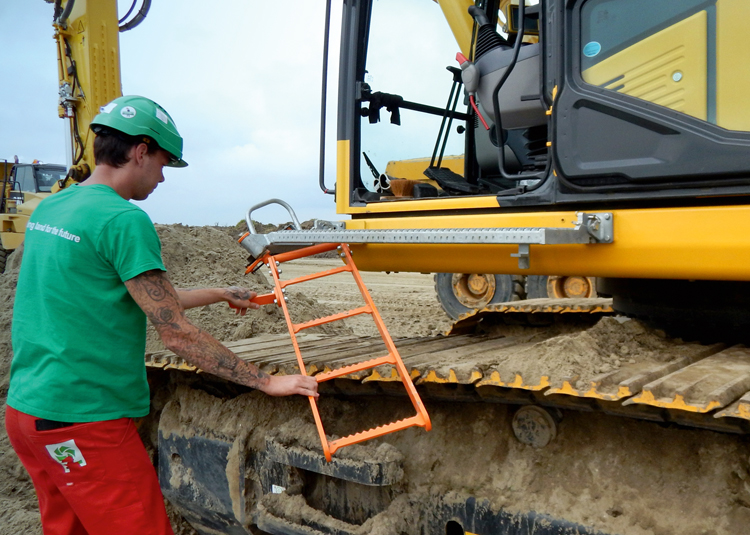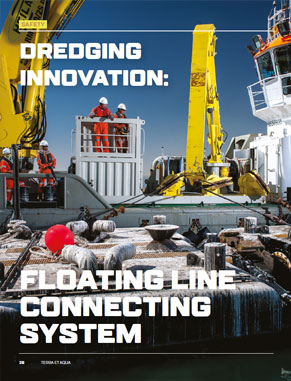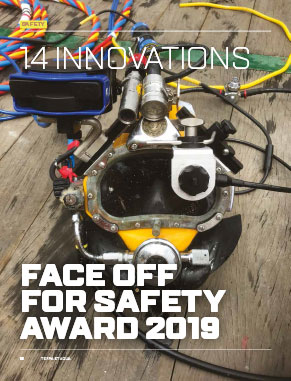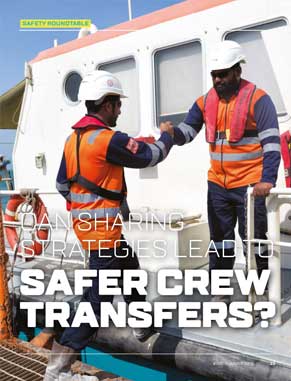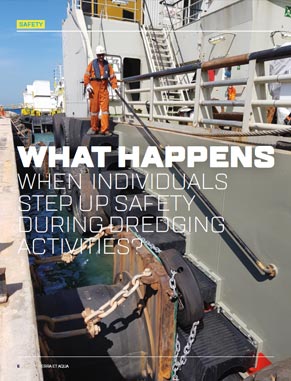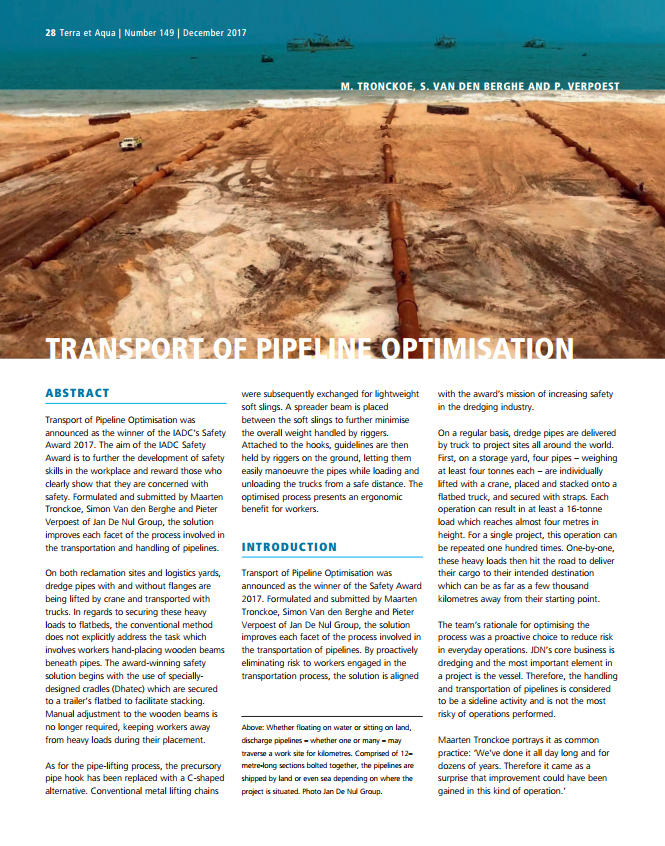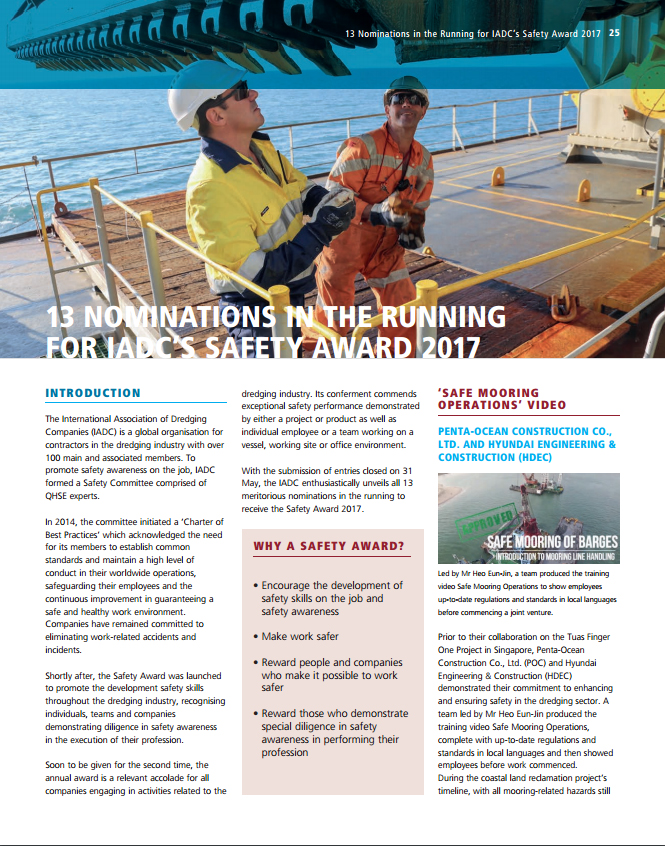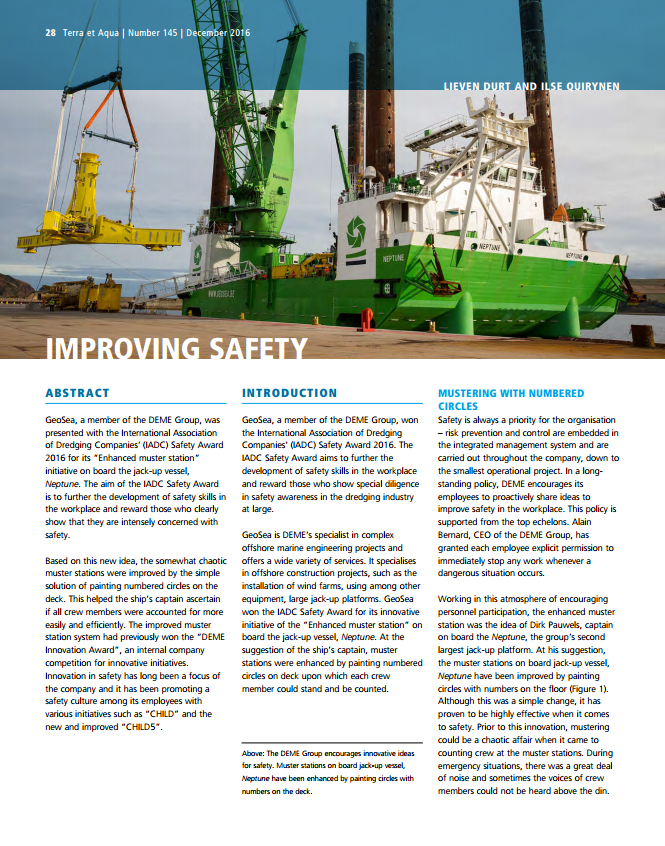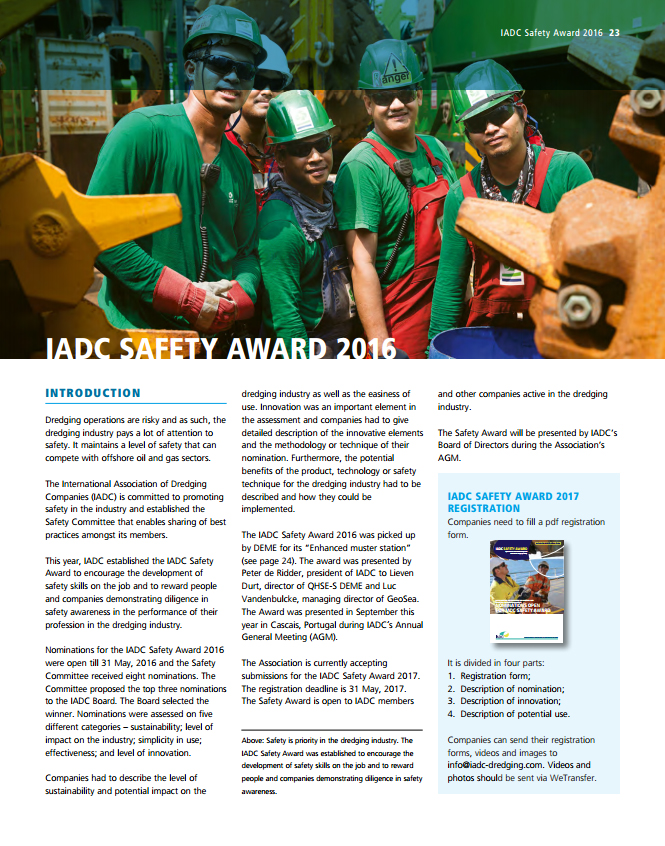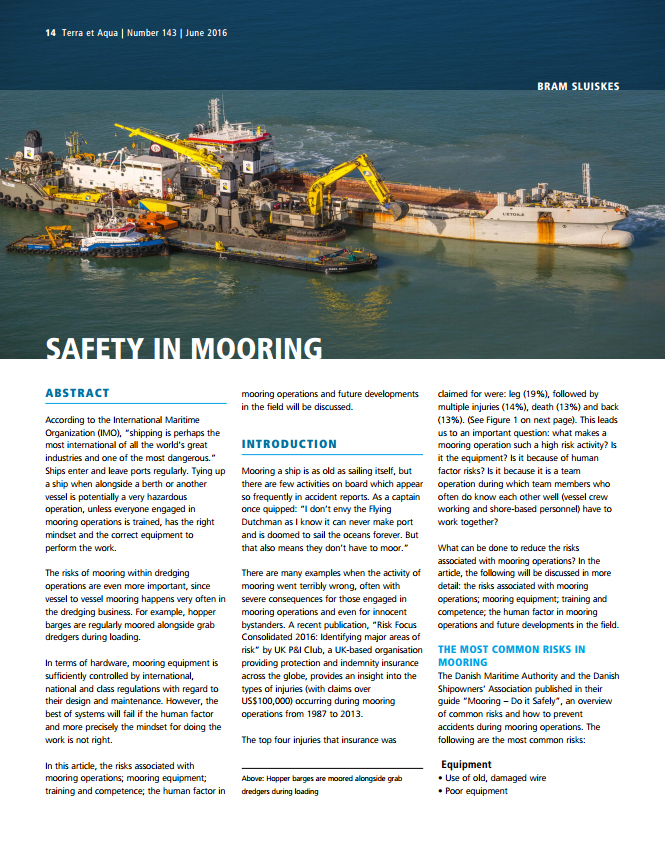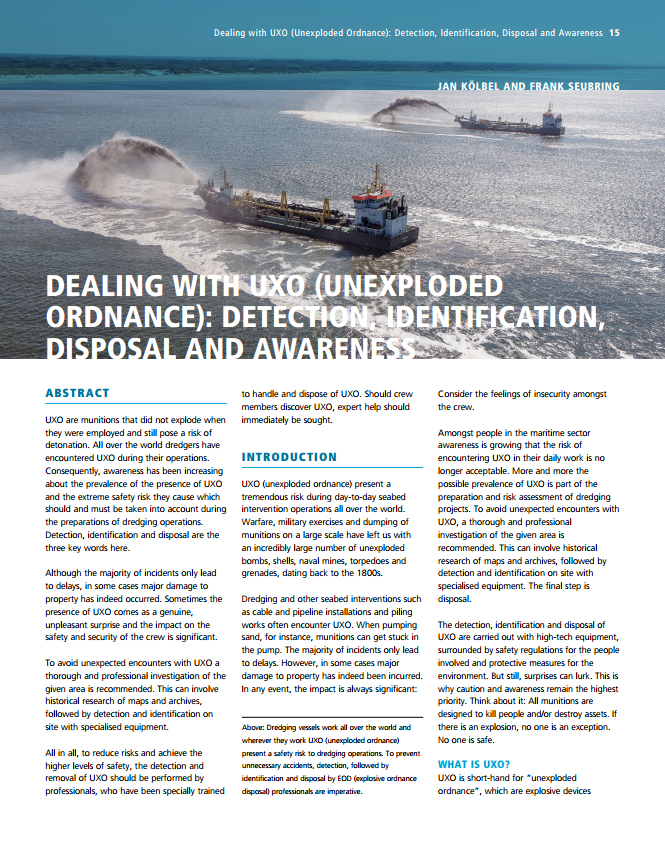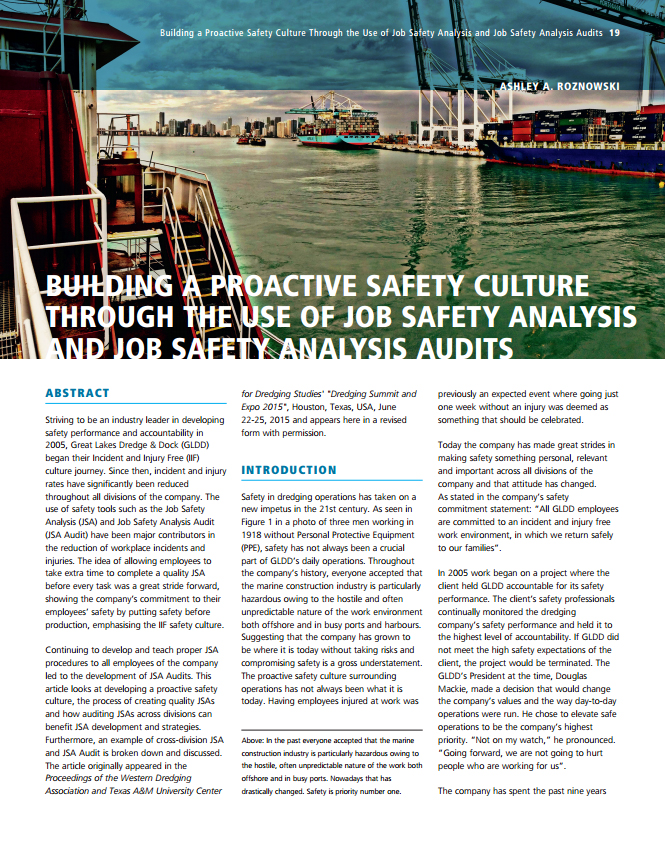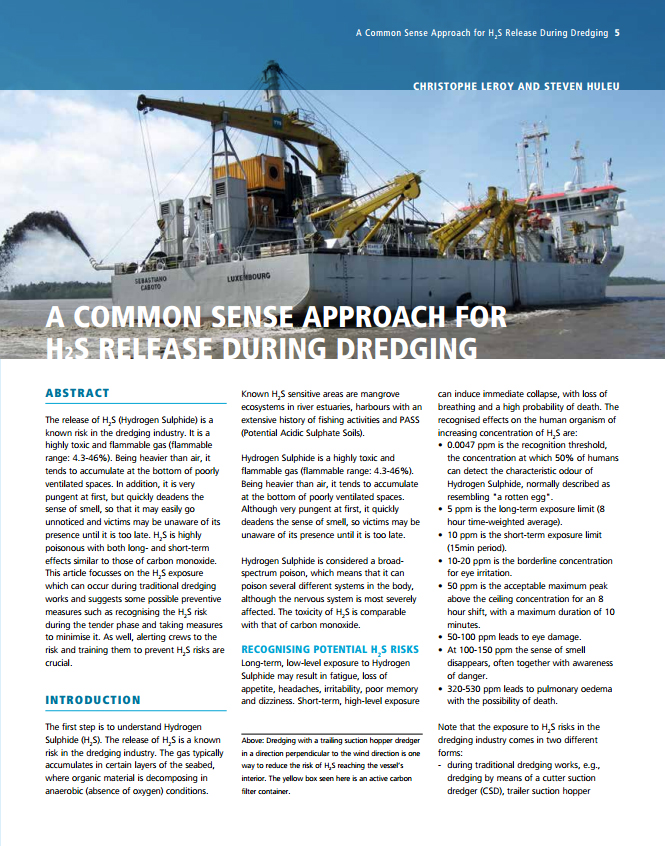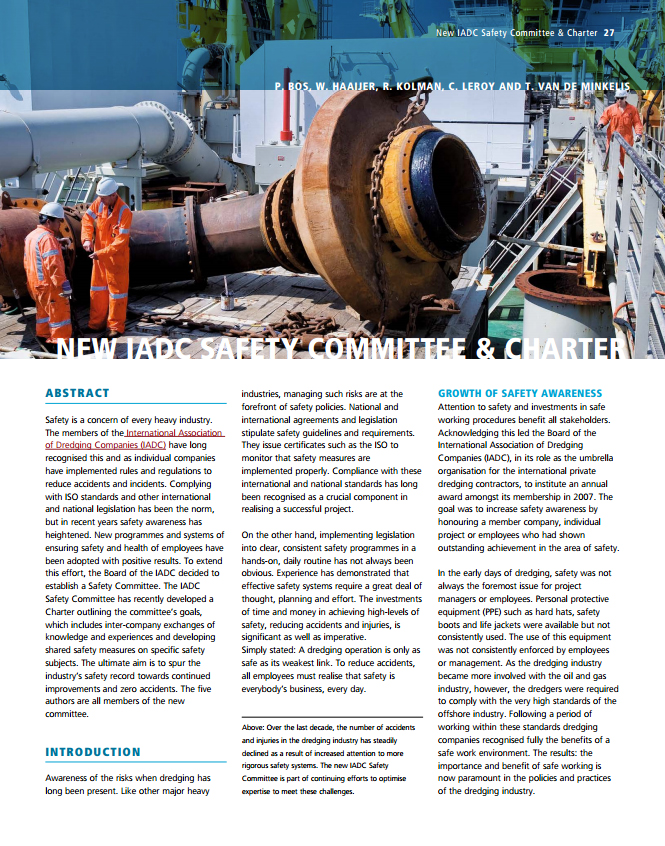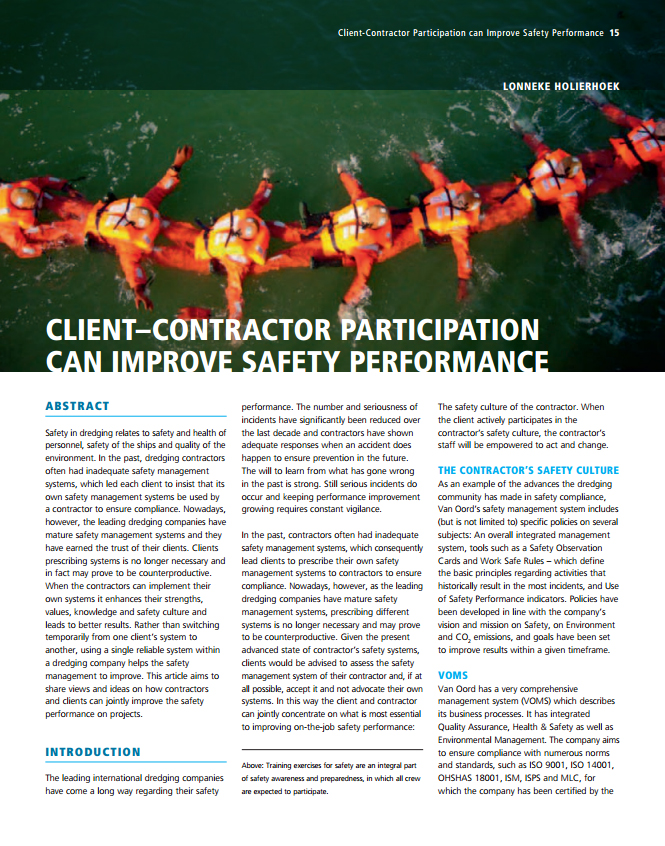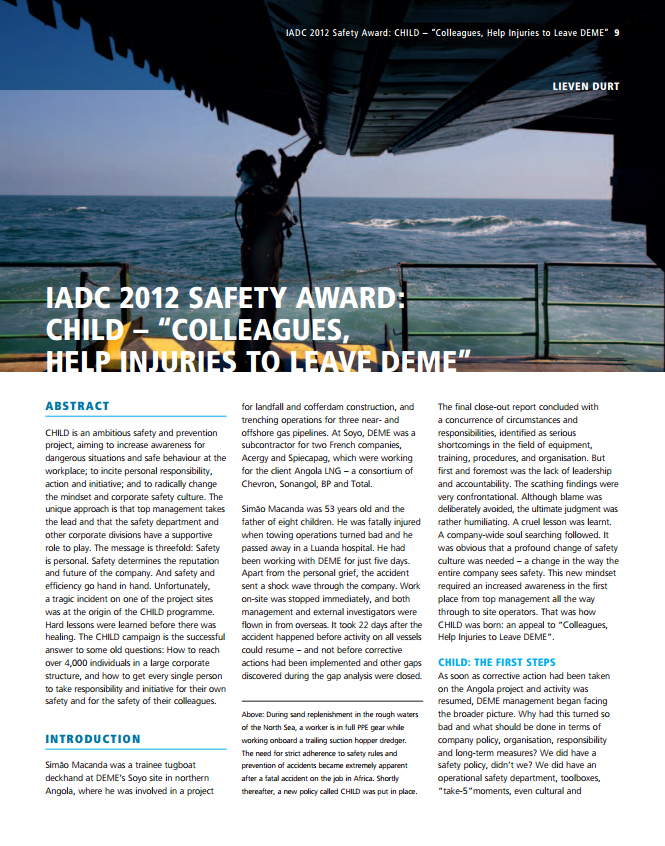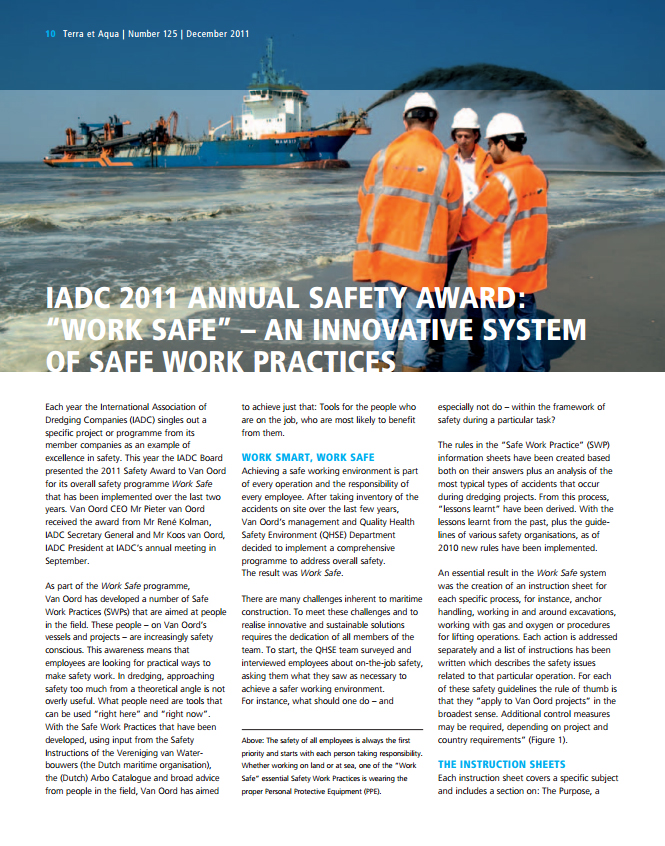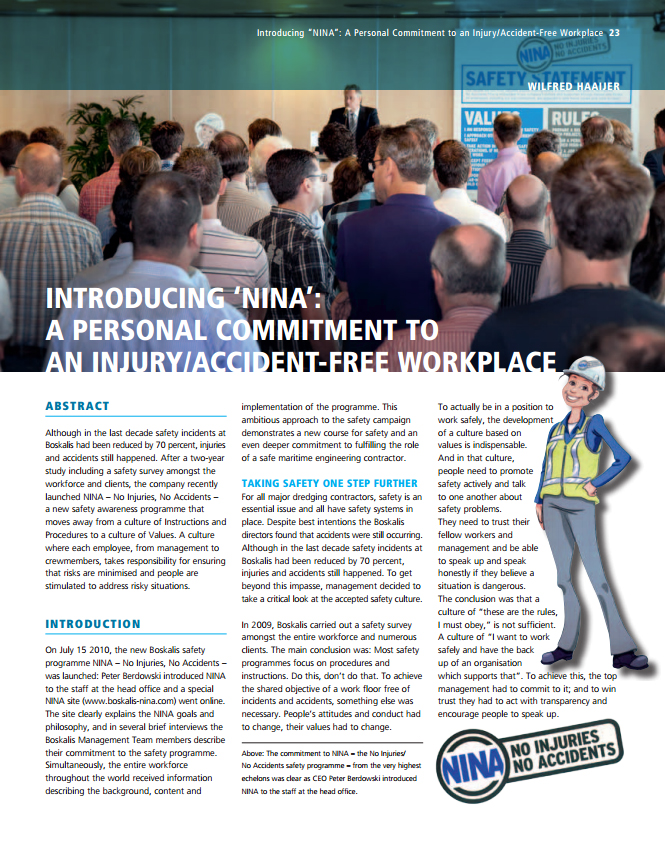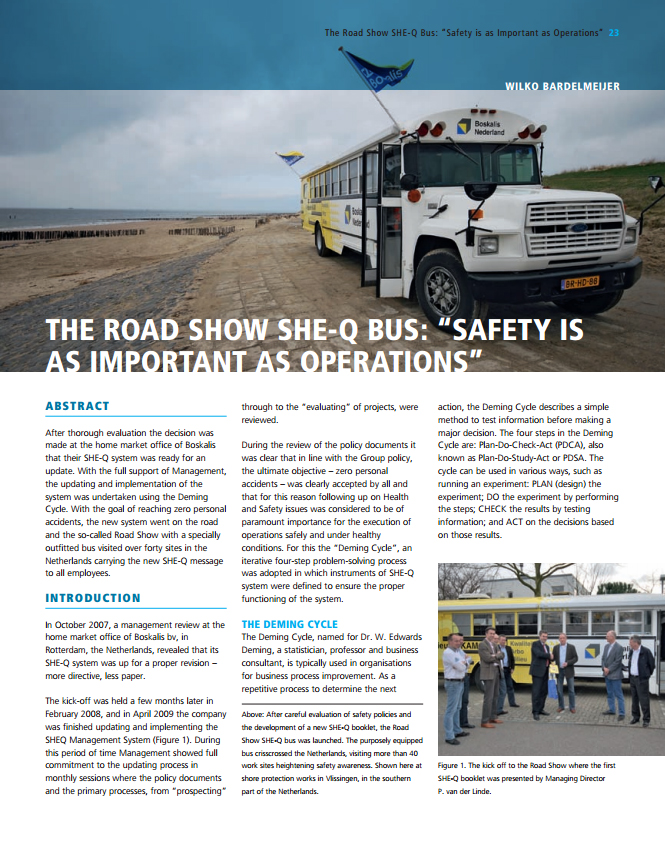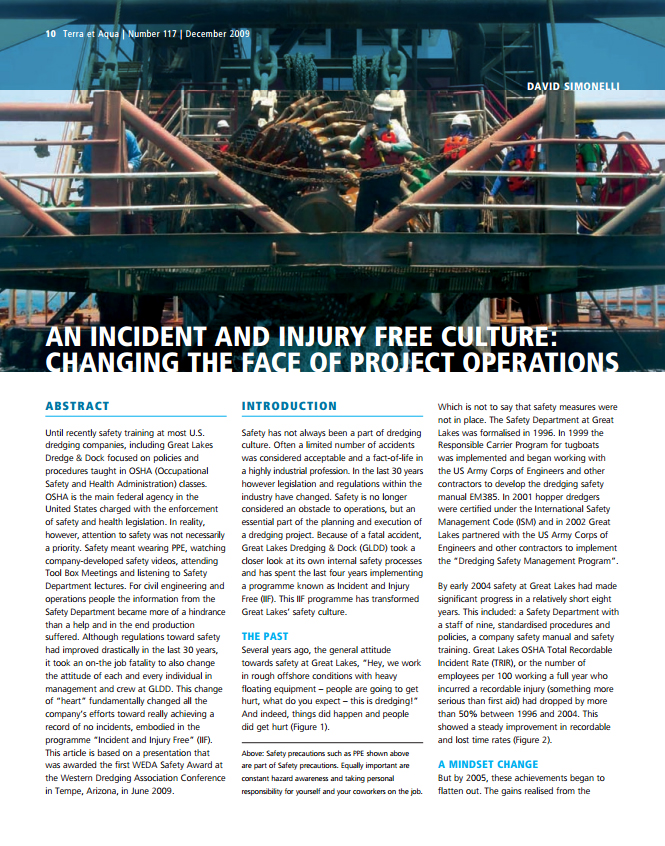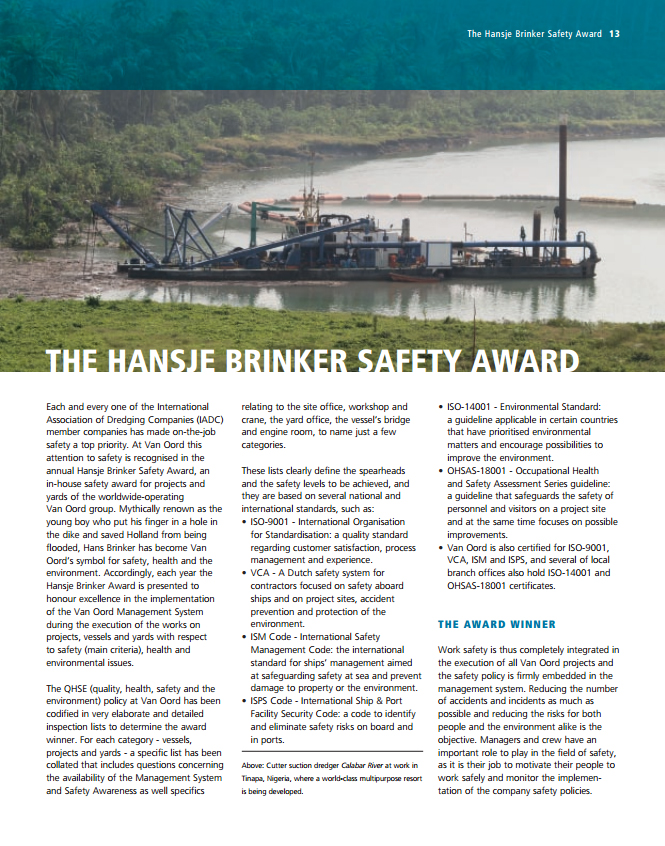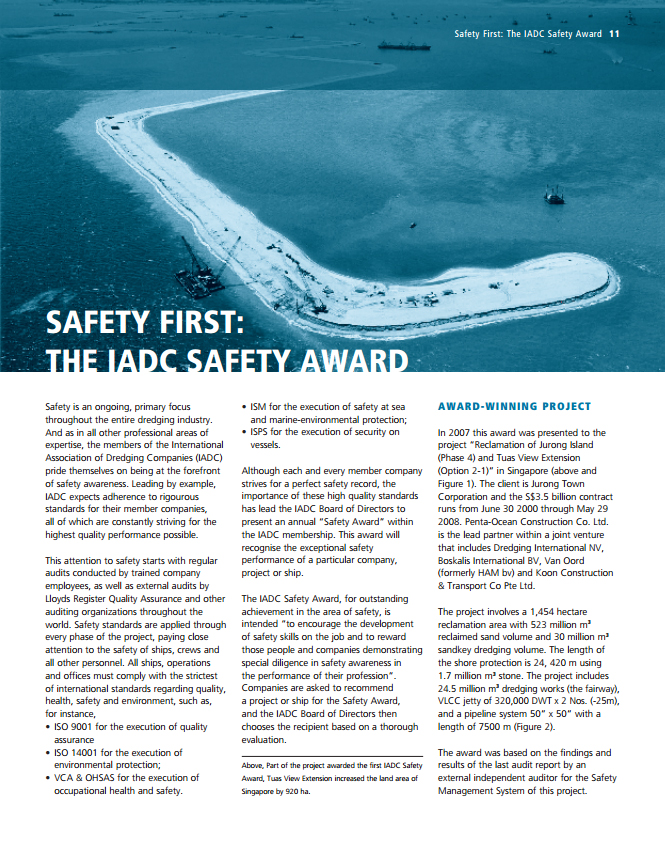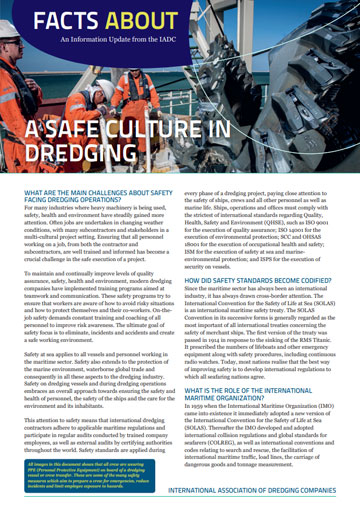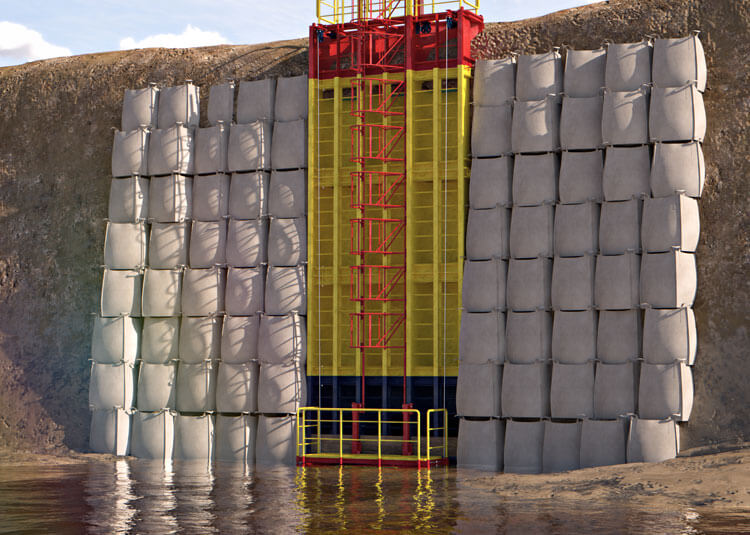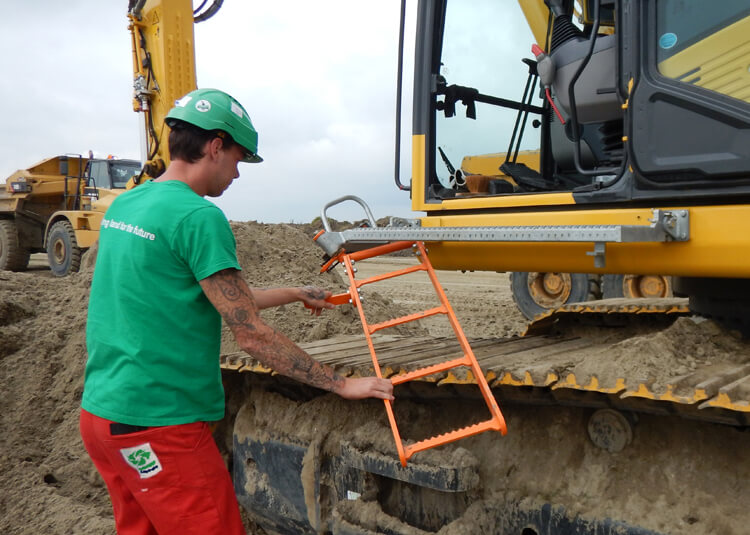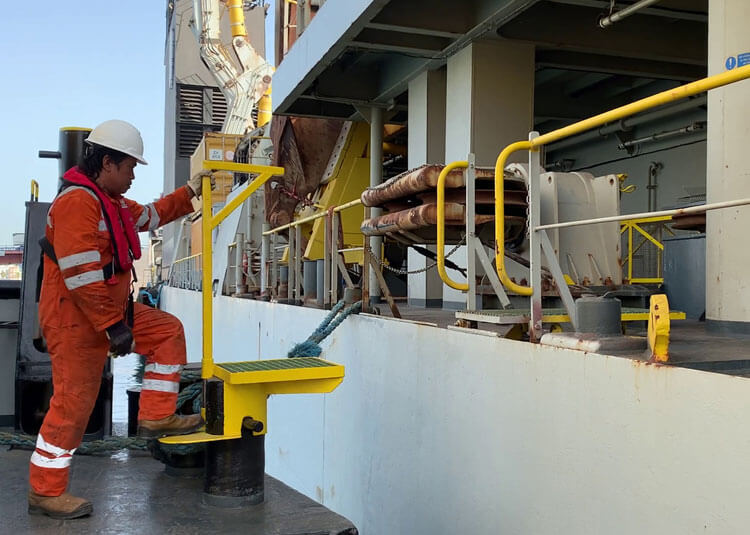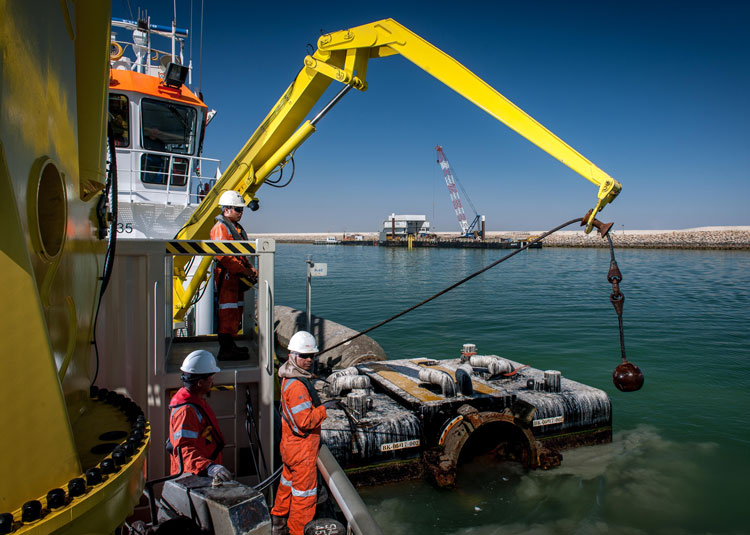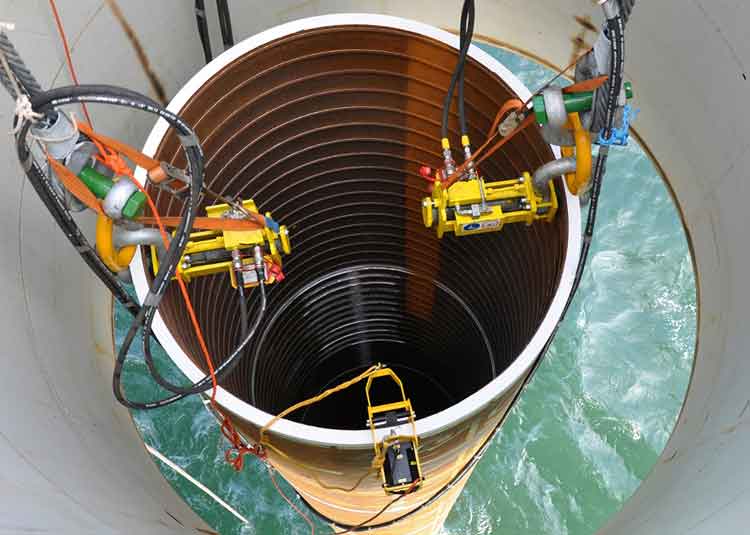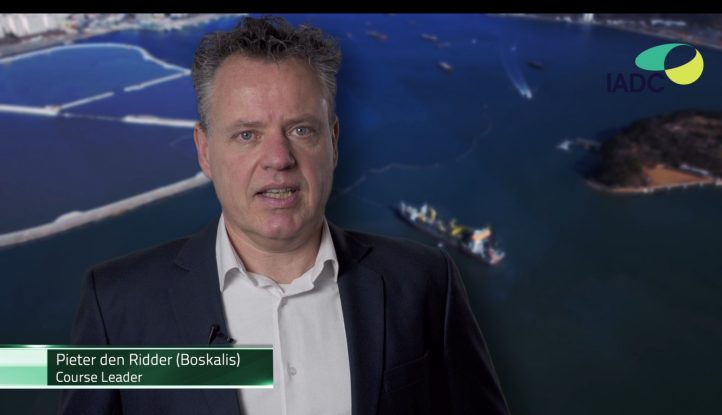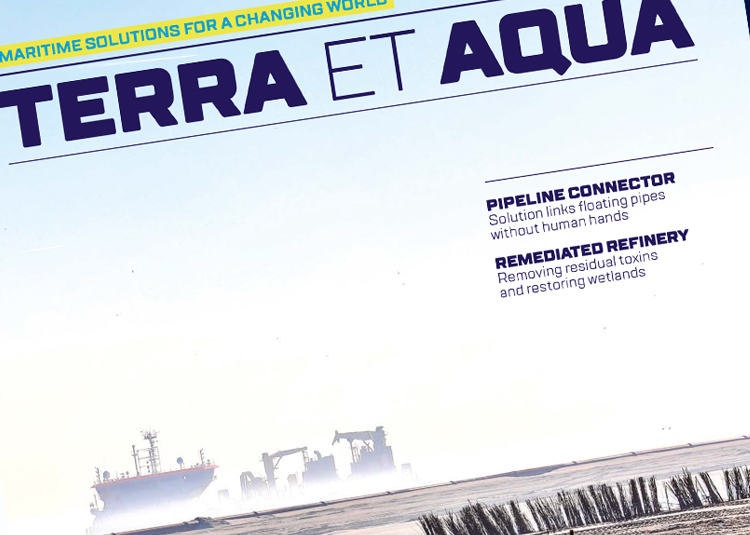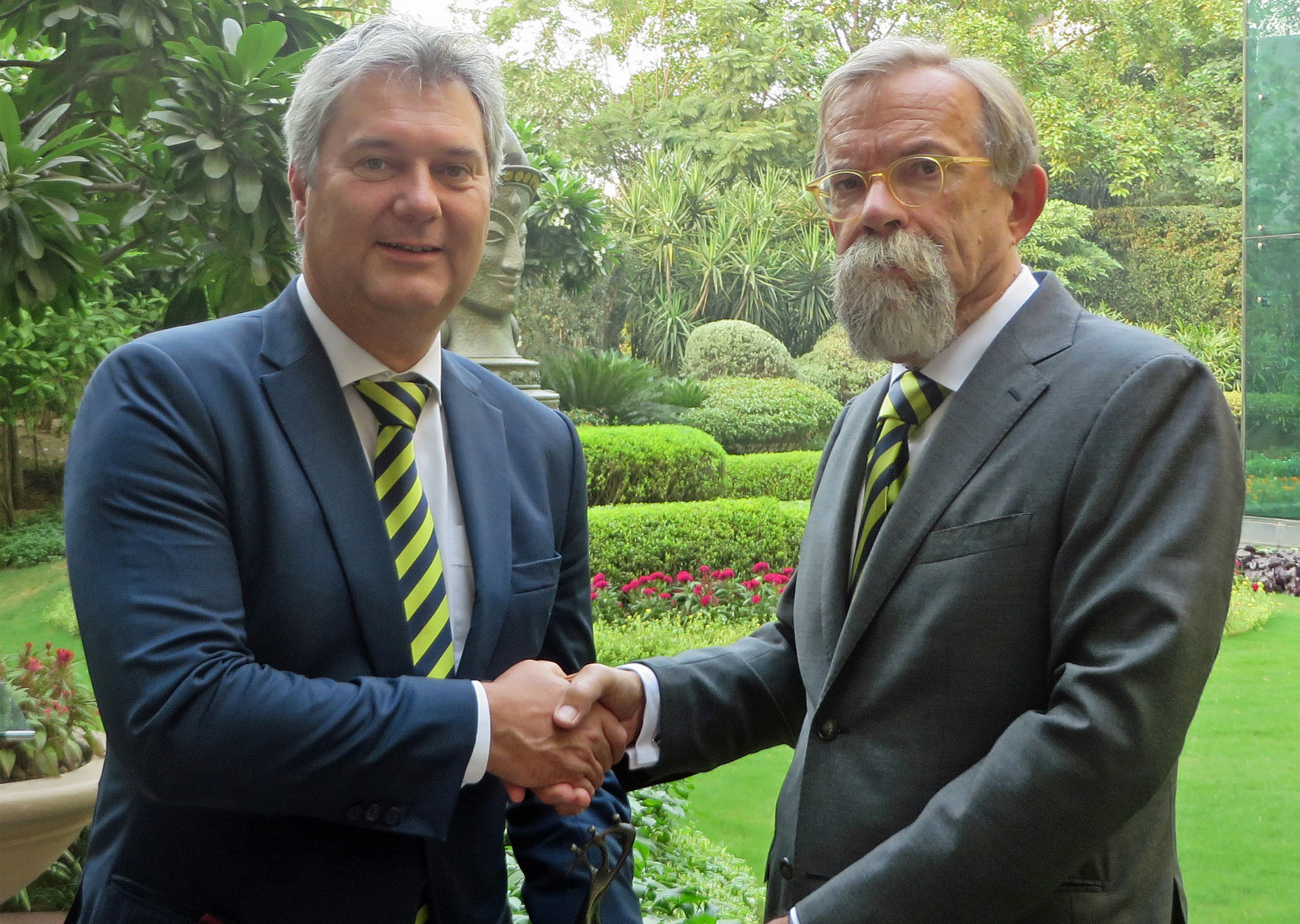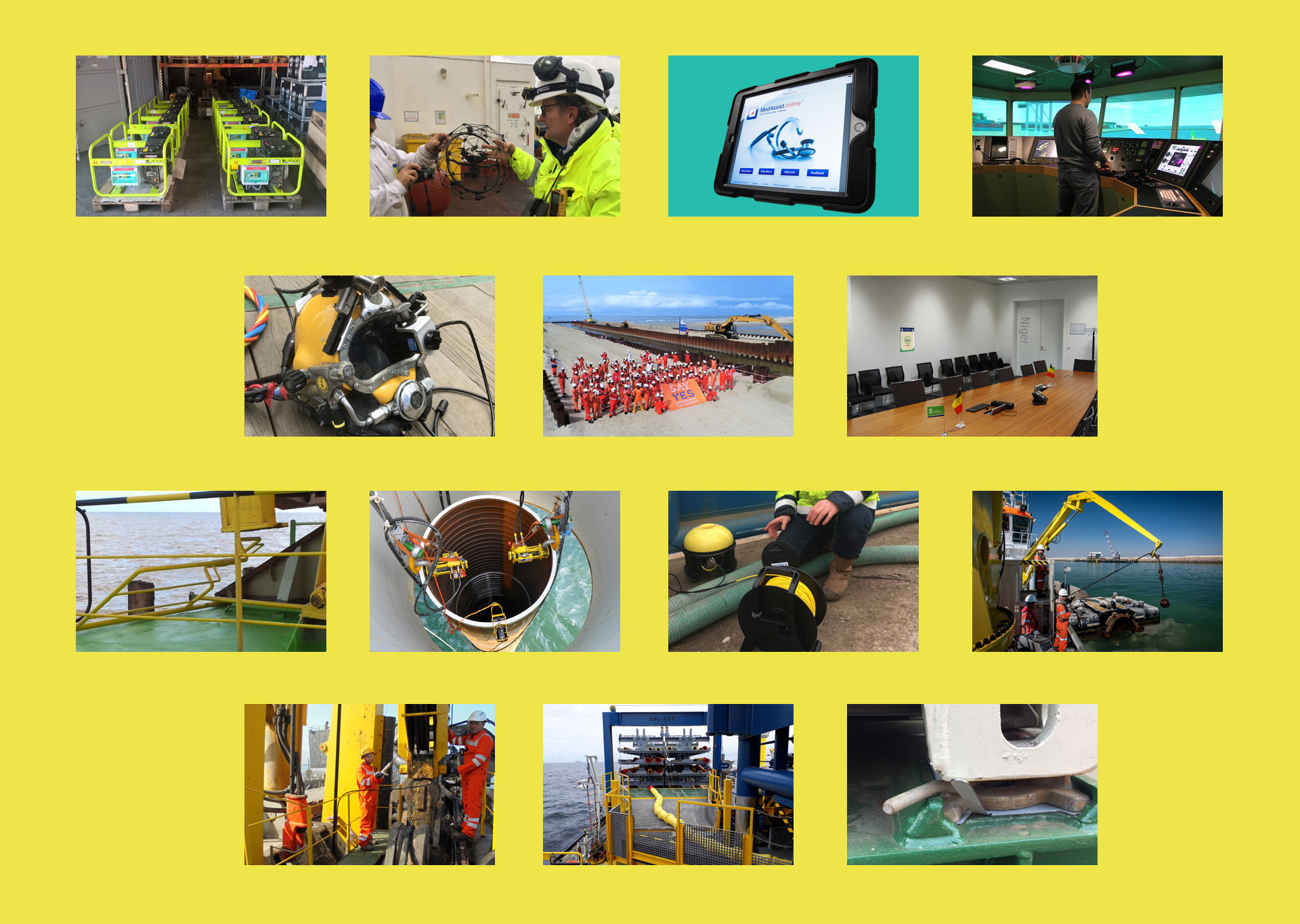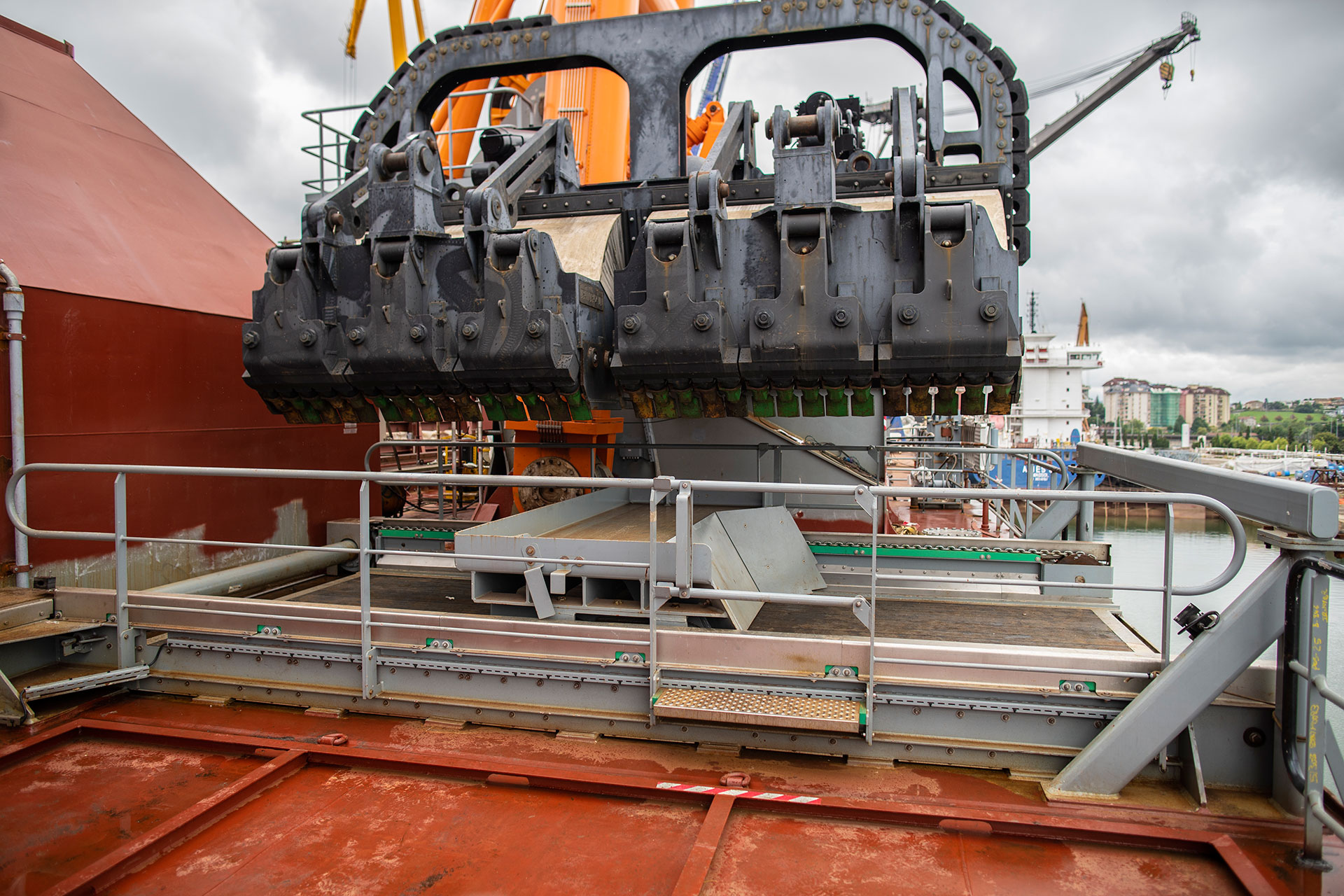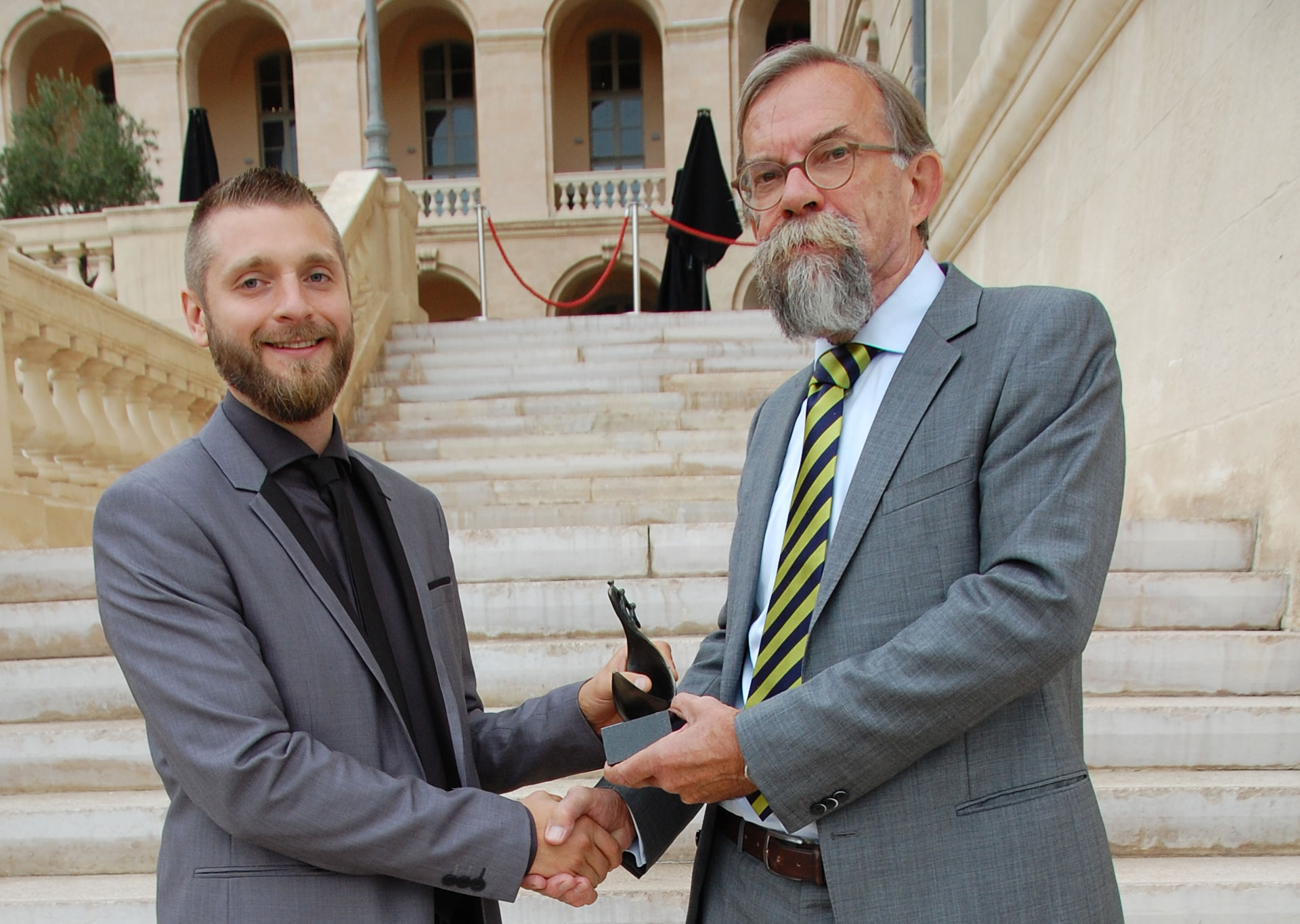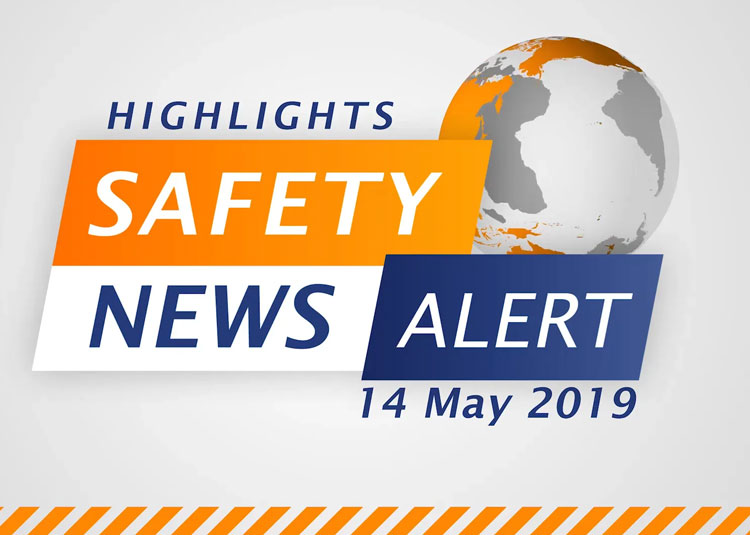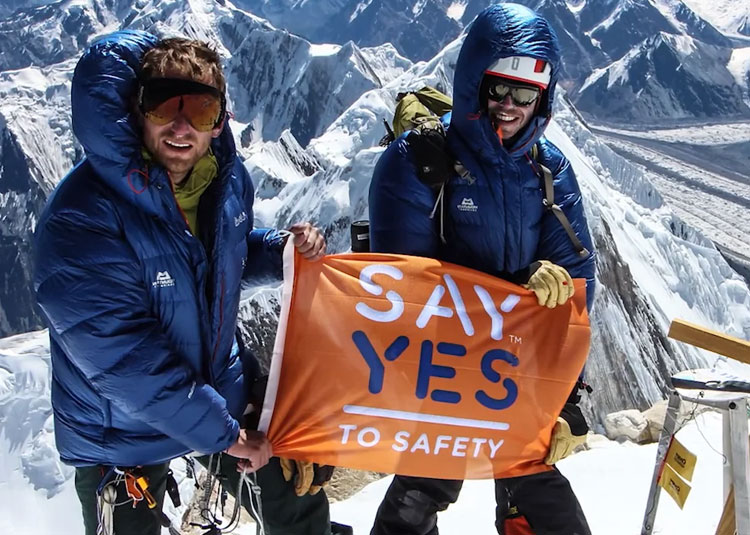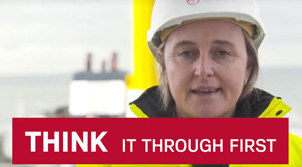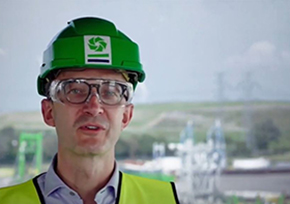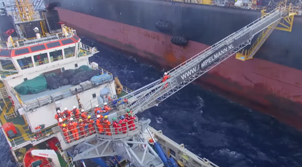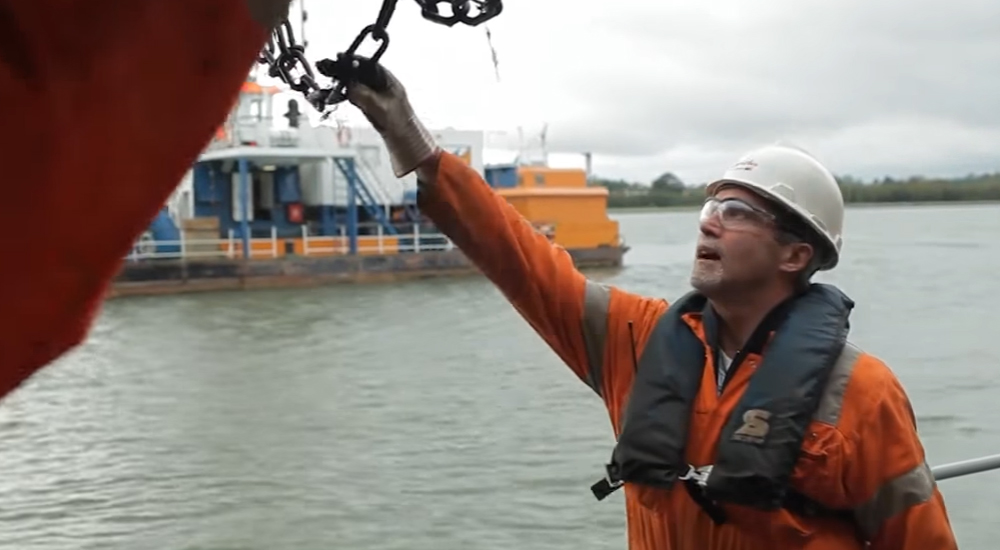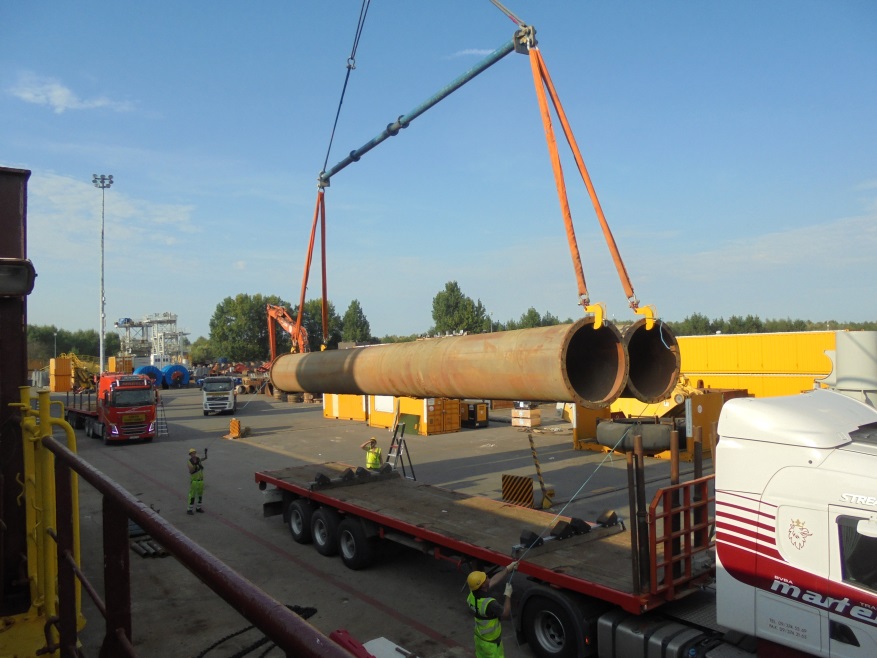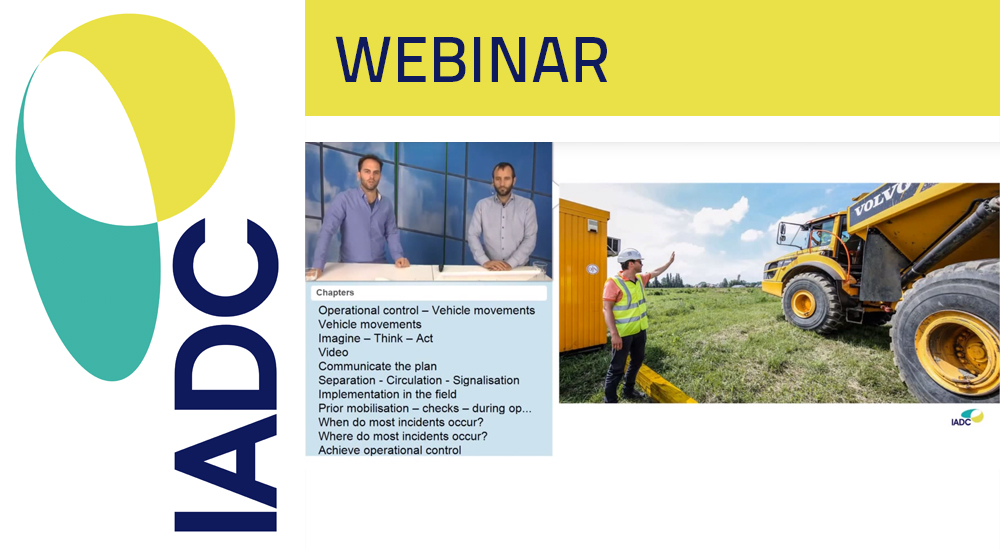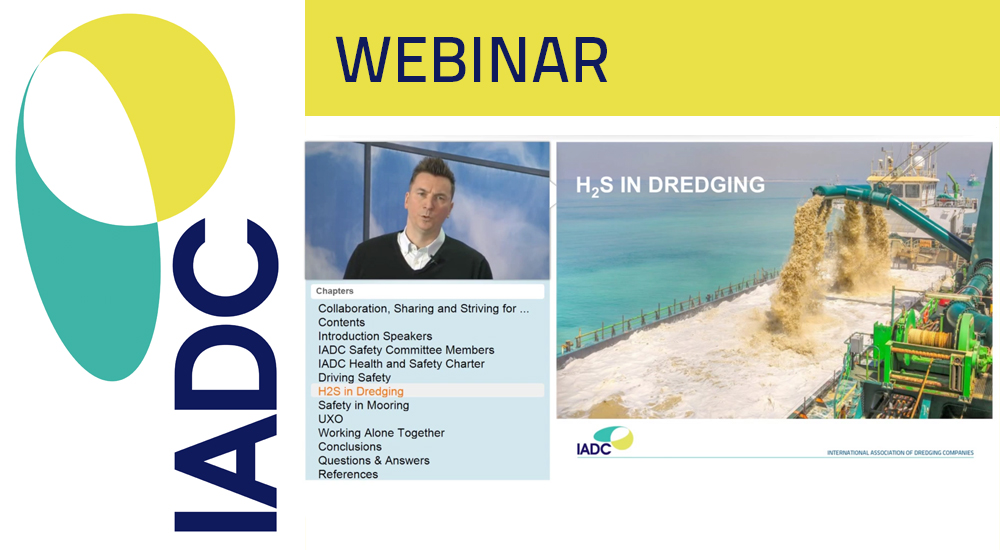Safety at sea applies to all vessels and personnel working in the maritime sector. It is also the highest priority during any dredging operation.
Safety on dredging vessels and during dredging operations embraces a comprehensive approach towards ensuring the safety and health of personnel, the safety of the ships and the quality of the environment.
To achieve this, international dredging contractors strive to comply with applicable international and national maritime regulations. Contractors also participate in regular audits conducted by trained company employees, as well as external audits by certifying authorities throughout the world.
Safety standards
Safety standards are applied during every phase of a dredging project, paying close attention to the safety of ships, crews and all other personnel as well as to marine life. Ships, operations and offices must comply with the strictest of international standards regarding Quality, Health, Safety and Environment (QHSE).
The International Organization for Standardization (ISO), for instance, develops standards according to the principles of voluntary, industry-wide consensus. International Safety Management (ISM) Code also created guidelines. A few examples include:
- ISO 9001:2008 for the execution of quality assurance;
- ISO 14001:2004 for the execution of environmental protection;
- SCC and OHSAS 18001:2007 for the execution of occupational health and safety;
- ISM for the execution of safety at sea and marine-environmental protection;
- ISPS for the execution of security on vessels.
International Maritime Organization (IMO)
In 1959 the International Maritime Organization (IMO) was established and immediately adopted a new version of the International Convention for the Safety of Life at Sea (SOLAS). Thereafter the IMO developed and adopted:
- international collision regulations;
- global standards for seafarers (COLREG);
- international conventions and codes relating to search and rescue;
- the facilitation of international maritime traffic and load lines;
- the carriage of dangerous goods and tonnage measurement.
Another convention under the IMO is MARPOL 73/78, the International Convention for the Prevention of Pollution from Ships. “MARPOL 73/78” is an abbreviation for marine pollution and 73/78 for the years 1973 and 1978.) MARPOL is the main international convention covering prevention of pollution of the marine environment by ships from routine operations or accidental causes and has been updated by several amendments over the course of time.
Establishing regulations of these various safety standards, however, does not necessarily mean the regulations are easily implemented.
Customised company safety programmes
Safety in dredging operations has taken on a new urgency in the last few decades. While government regulations are far-reaching, implementation of safety regulations is dependent on the individual companies. It demands the concerted efforts of dredging contractors to improve their own standards.
The reduction of injury and incidents during dredging operations has become a clear priority amongst the major dredging companies. Seeking to prevent industrial accidents and personal tragedies, contractors have developed their own customised safety programmes.
Simply abiding by the recognised standard international codes and establishing systems for avoiding unnecessary risk and limiting the number of injuries and incidents is not enough. To make safety a reality, company programmes require a sincere commitment from management and staff. They require a commitment to investments in training and workshops in order to bring complete awareness to both management and the work floor.
While safety regulations and legislation are clear, raising awareness and developing a culture of safety amongst personnel demands extra efforts.
Safety culture
The development of a pro-active ‘safety culture’ must involve each and every employee, from top management to workers, on board ships and on shore. Each and every employee must feel that they are part of a team and that they need to feel responsible for safety and performance and to take actions that demonstrate this.
To have a pervasive safety culture means that all personnel must feel they can have direct access to the highest levels of management.
Generally speaking, safety policies are divided into four categories:
- health and human resources,
- quality assessment,
- environment,
- security of vessels.
The overall strategy of dredging industry is to reduce lost-time incidents, to limit the frequency of accidents, to ensure a more efficient operation and, most importantly, to lower risks for employees.
Safety training, coaching and leadership
Major dredging companies have instituted programmes for all personnel including management. These can take the form of seminars and workshops as well as “Toolbox talks” which are meetings or presentations organised on the job, prior to the start of the job, that is, close to the toolbox.
Issues that may arise regularly are discussions on Personal Protective Equipment (PPE), working with pipelines, with chemicals, exposure to hazardous materials, lifeboat training exercises, care at excavation sites, mooring lines and the correct procedures for working with heavy machinery.
Safety for all
As with many major infrastructure projects, jobs are often undertaken with many subcontractors with their specialised areas of expertise. Ensuring that all personnel working on a job, from both the contractor and subcontractors, are well trained has become a crucial challenge in the safe execution of a dredging project.
To maintain and continually improve levels of quality assurance, safety, health and environment, the major dredging companies have implemented training programmes aimed at teamwork and communication.
For companies working all over the world, this also means the need to develop cross-cultural communication skills. Not only language proficiency but also cultural norms may need to be addressed to ensure that all workers on all levels are aware of how to avoid risky situations and how to protect themselves and their co-workers.
TAGS
related
Articles
Submissions for IADC’s Safety Awards 2022
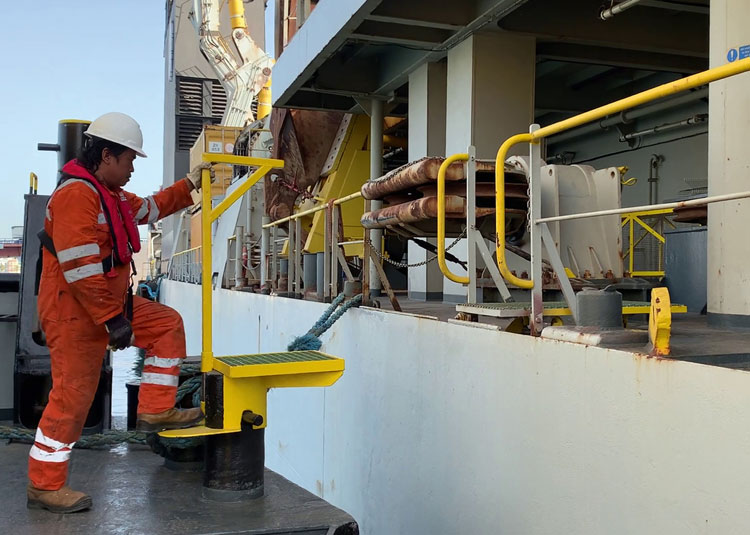
When individual employees, teams and companies view everyday processes and situations through a continuous lens of safety, they can each contribute to making all aspects of operational processes, whether on water or land, safer. For the 2022 Safety Awards, IADC’s Safety Committee received 11 submissions. Each one is assessed on five different categories; sustainability; level of impact on the industry; simplicity in use; effectiveness; and level of innovation.
Building a proactive safety culture within a marine contractor organisation
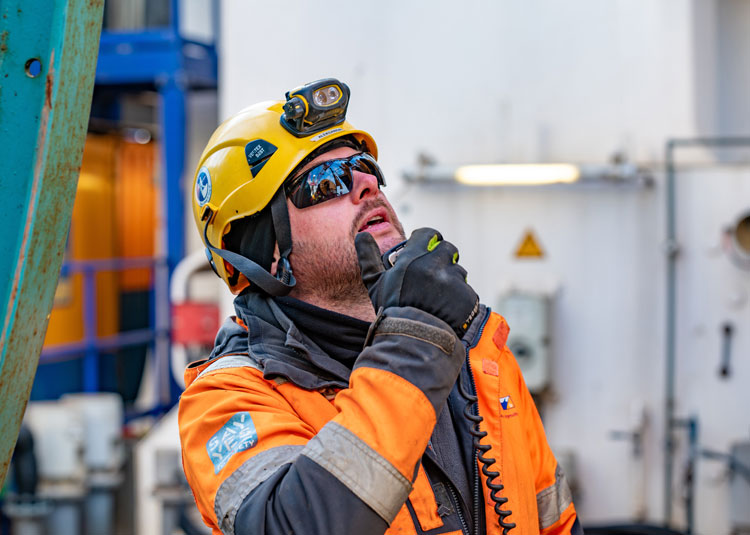
It is hard to imagine a time when safety was not deemed important, when Personal Protective Equipment (PPE) was not used and little was done in the way of prevention. A few decades ago, occupational health and safety was not considered as important for the vast majority of companies. Instead, incidents and emergencies were handled as they occurred, as effectively as possible given the limited technology and resources available. Today, those times have changed. This article explores the progress of health and safety in the dredging industry and QHSSE professionals, Ton van de Minkelis and Christophe Leroy share their experiences in building a proactive safety culture.
Young Author Award winners: Where are they now?
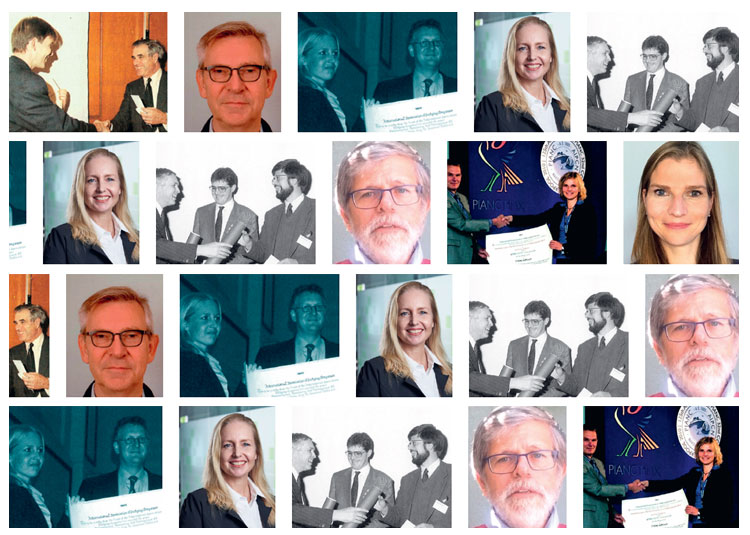
Each year, at selected conferences, the Conference Paper Committee is asked to recommend a prize winner whose paper makes a significant contribution to the literature on dredging and related fields. Since 1987, IADC has presented 42 Young Author Awards. Curious to see where they are now, we asked previous winners what impact winning the award had on them and their career.
Keppel Offshore & Marine’s Safety Plus Programme
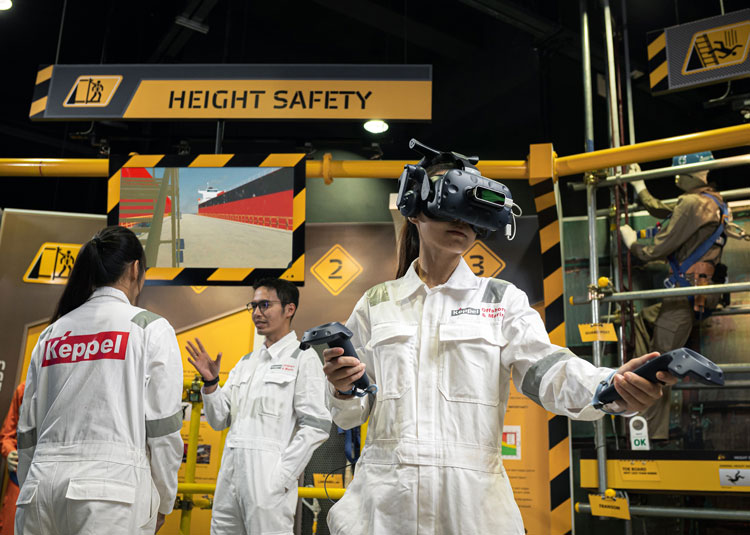
IADC’s Safety Committee and Board of Directors awarded the very first Safety Award to a supply chain organisation active in the dredging industry to Keppel FELS. The company was praised by the committee for the results of its safety programme and commitment to safety onsite. Anchored in Keppel Offshore & Marine’s Safety Plus Programme and Singapore's National WSH Vision 2028, Keppel FELS continues to consistently improve and enhance its existing Health, Safety and Environment (HSE) management systems.
Jan De Nul crew invents innovative bollard step
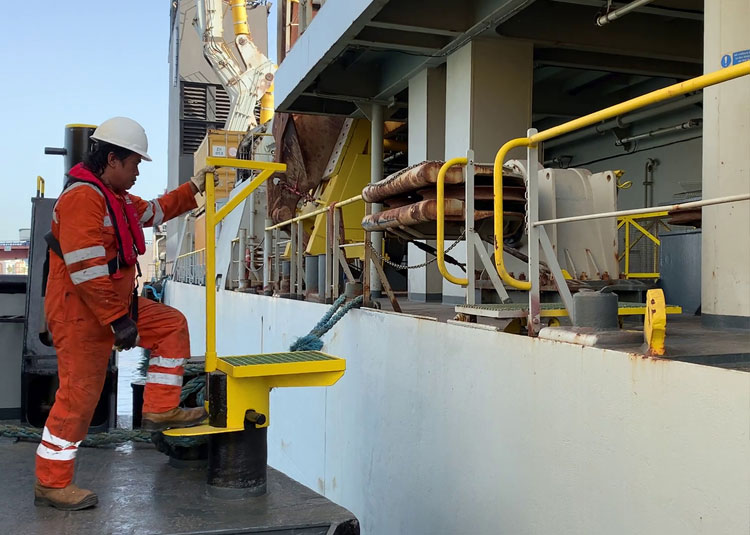
During marine transfers, it is essential to achieve a maximum level of control. With the bollard step, Jan De Nul has designed a simple solution to enhance safety during transfers of crew and visitors. This innovative idea came from the crew of the multicat DN46 and was picked up during an Operational Control meeting, where an advisory board discusses suggestions that improve the safety and efficiency of the company’s operations. ‘We stimulate all possible innovative ideas within our company’, says Quinten Schaumont, Area QHSSE advisor. ‘At all levels, at all times.’
Finding innovative solutions to improve safety
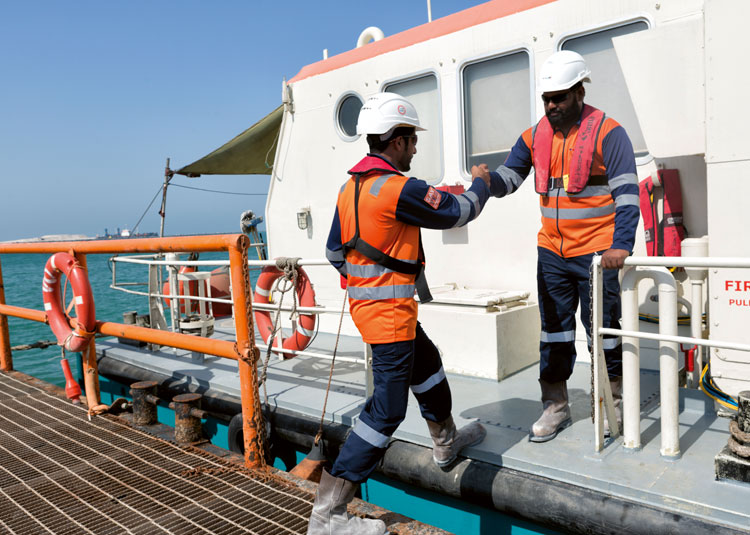
When individual employees, teams and companies view everyday processes and situations through a continuous lens of safety, they can each contribute to making all aspects of operational processes, whether on water or land, safer. For the 2021 Safety Awards, IADC's Safety Committee received 15 submissions. Each one is assessed on five different categories; sustainability; level of impact on the industry; simplicity in use; effectiveness; and level of innovation.
Interview: Panama Canal’s deputy administrator Ilya Espino de Marotta
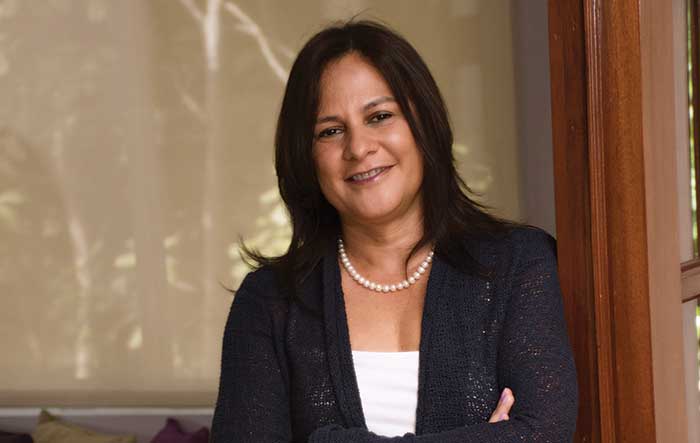
Armed with degrees in both Marine Engineering and Engineering Economics as well as 35 years – and counting – of experience at the Panama Canal Authority, Ilya Espino de Marotta has blasted through the glass ceiling wearing a pink hard hat. Amongst the diverse roles she has under her belt, ranging from Marine Engineer in the shipyard to Vice President for Transit Business, Ilya has notably led the Canal’s expansion as head engineer and now oversees operations from the second highest position at the authority.
Safety on Site
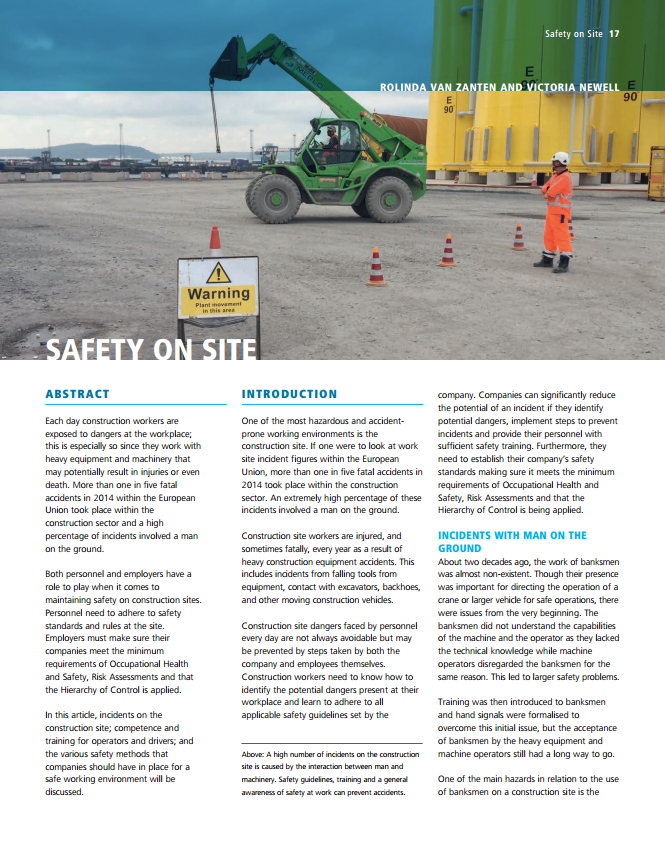
One in five fatal accidents occur in construction and a high percentage of it involves a man on the ground. This article explains how companies can significantly reduce the number of potential accidents on the construction site by implementing strict safety protocols; separating pedestrians and machinery on the site; and what employees can do to maintain a safe working environment.
Creating a “Culture of Safety”
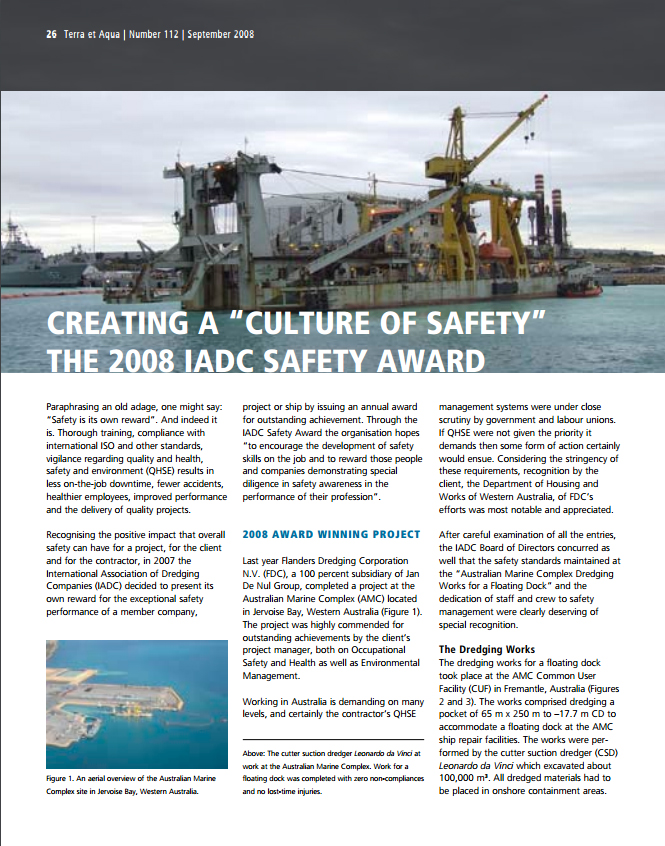
This year’s IADC Safety Award winner proves that thorough training, compliance with ISO and other standards, vigilance regarding quality and health, safety and environment (QHSE) results in less on-the-job downtime, fewer accidents, healthier employees, improved performance and the delivery of quality projects.
News
And the Safety Award 2018 goes to….Van Oord for the Debris Removal Platform!
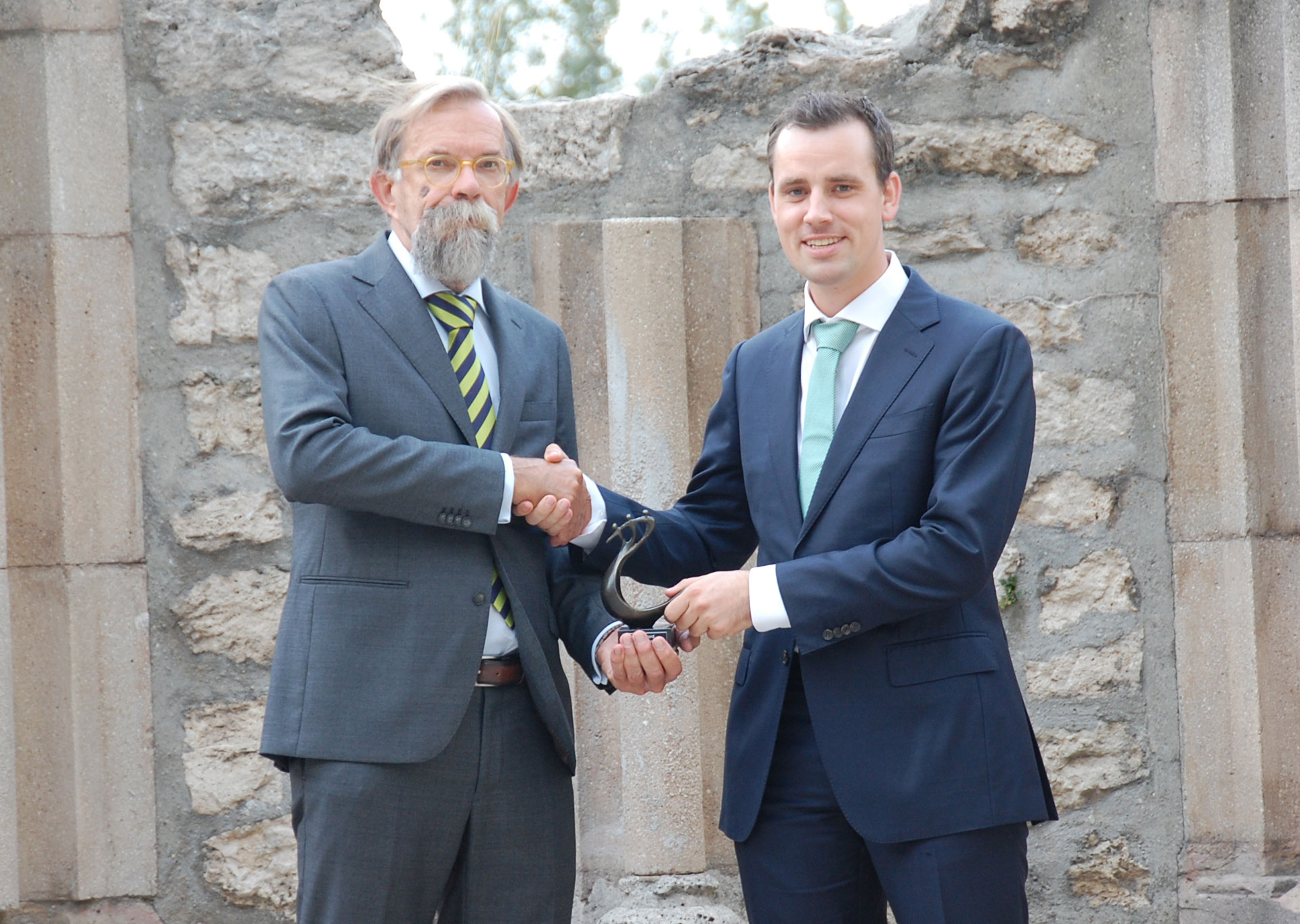
To promote innovations within the realm of safety within the dredging industry, the International Association of Dredging Companies gives a Safety Award to an exemplary programme, procedure or project each year. Winner Announced at the IADC’s Annual General Meeting, the winner of the Safety Award 2018 is Van Oord’s Debris Removal Platform. Van Oord changed the existing technique of manually removing debris to an automated
Safety Award 2017: nominations
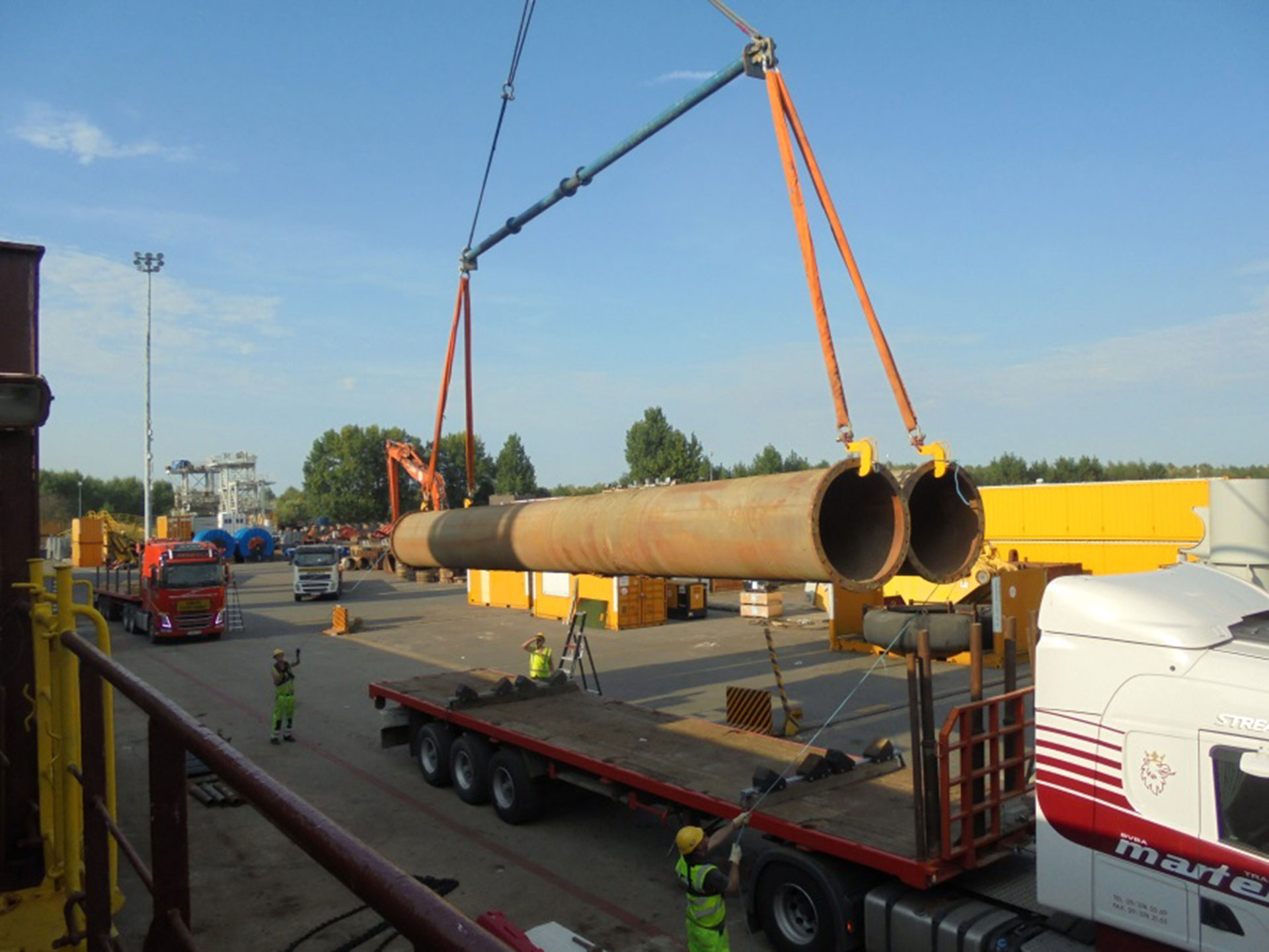
Dredging operations are risky business, therefore the dredging industry pays a lot of attention to safety. Launched in 2015, the IADC Safety Award is intended to encourage the development of safety skills on the job, rewarding people and companies demonstrating diligence in safety awareness in the performance of their profession. Soon to be given for the second time, the Saf
DEME wins IADC Safety Award 2016
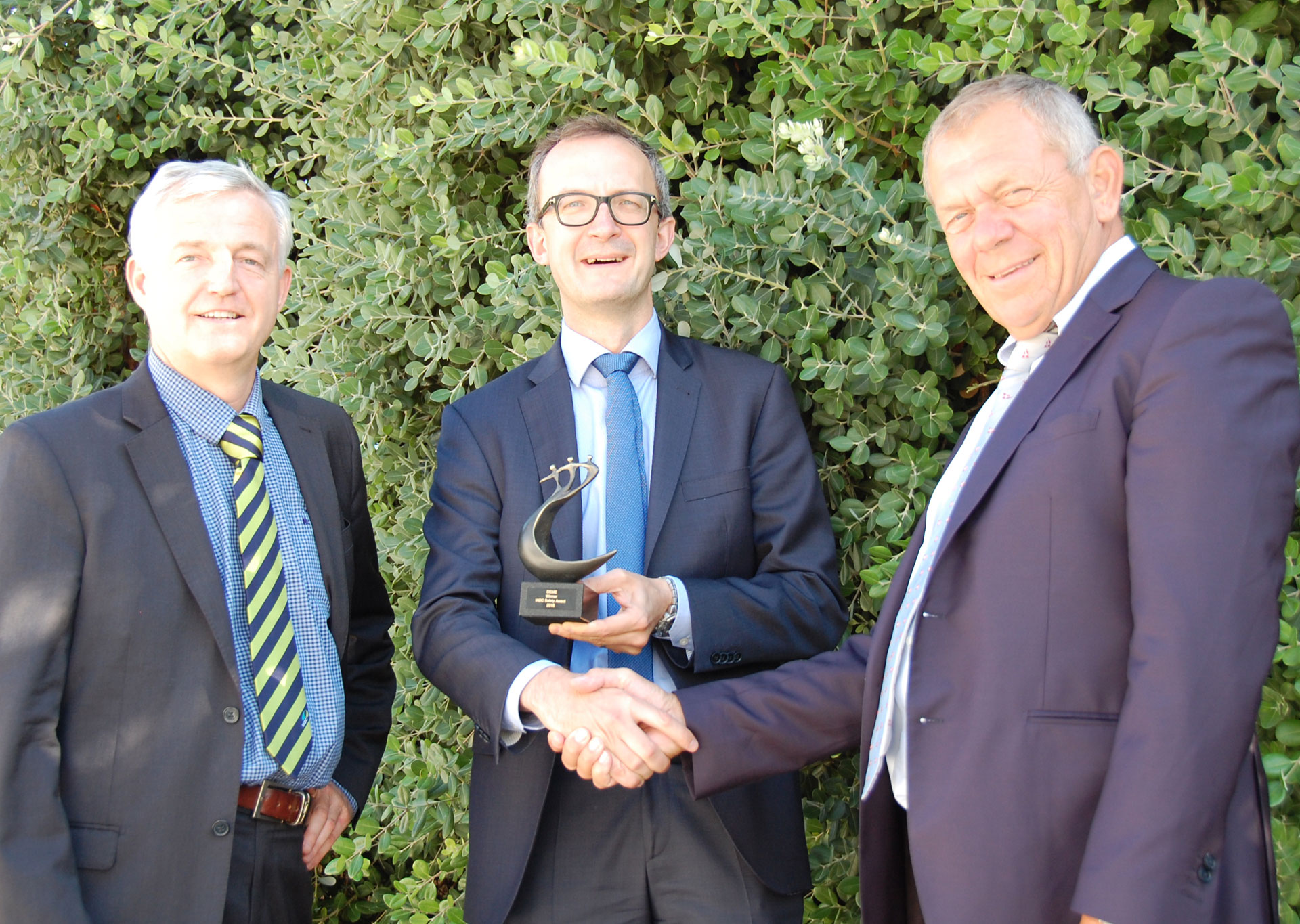
DEME picked up the prestigious IADC Safety Award at IADC’s Annual General Meeting (AGM) last week at Cascais, Portugal. The award is given to honour companies that have shown outstanding achievement in the area of safety. The award was presented by Peter de Ridder, president of IADC to Lieven Durt, director of QHSE-S DEME and Luc Vandenbulcke, managing director of GeoSea. The company was chosen as a winner by the Safety Committee from among
Safety Award 2016: nominations
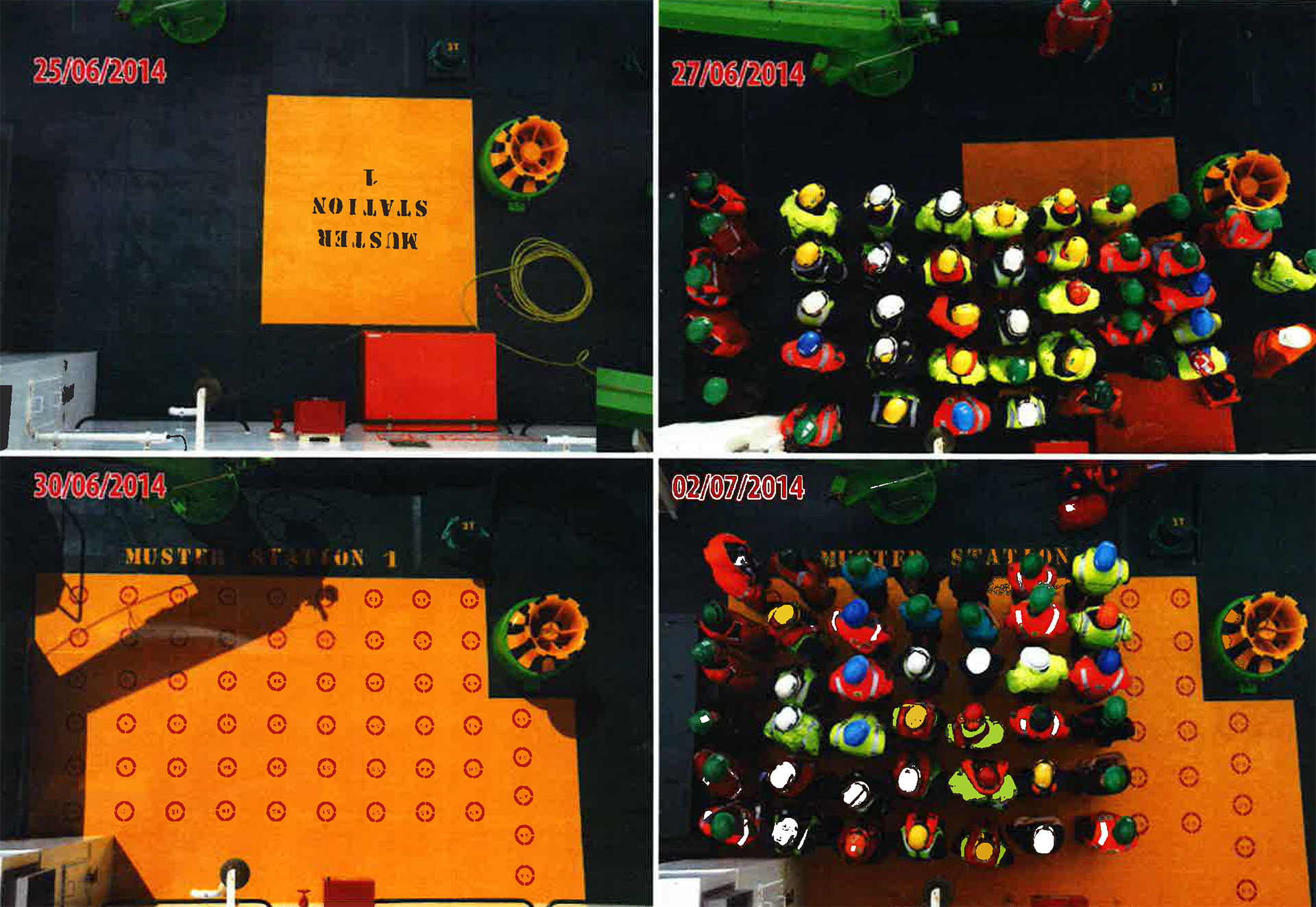
The Safety Committee has chosen eight nominations for the IADC Safety Award. IADC will be announcing one nomination every Monday per week, starting from 25 July, 2016. FIRST NOMINATION The first nomination is for Jan De Nul Australia’s “Fully Automated TSHD Mooring” system. During the dredging and reclamation works of Brisbane Airport Corporation, JDN Aust
Videos
Safety Award 2018 Winner: Van Oord Debris Removal Platform
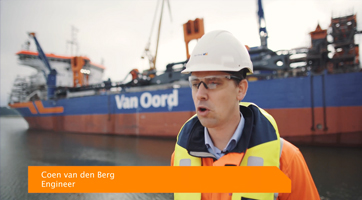
To promote innovations within the realm of safety within the dredging industry, the International Association of Dredging Companies gives a Safety Award to an exemplary programme, procedure or project each year. Announced at the IADC’s Annual General Meeting, the winner of the Safety Award 2018 is Van Oord’s Debris Removal Platform. Van Oord changed the existing technique of manually removing debris to an automated system, reducing the risk of personal injury.
DEME wins IADC Safety Award: “Enhanced Muster station”
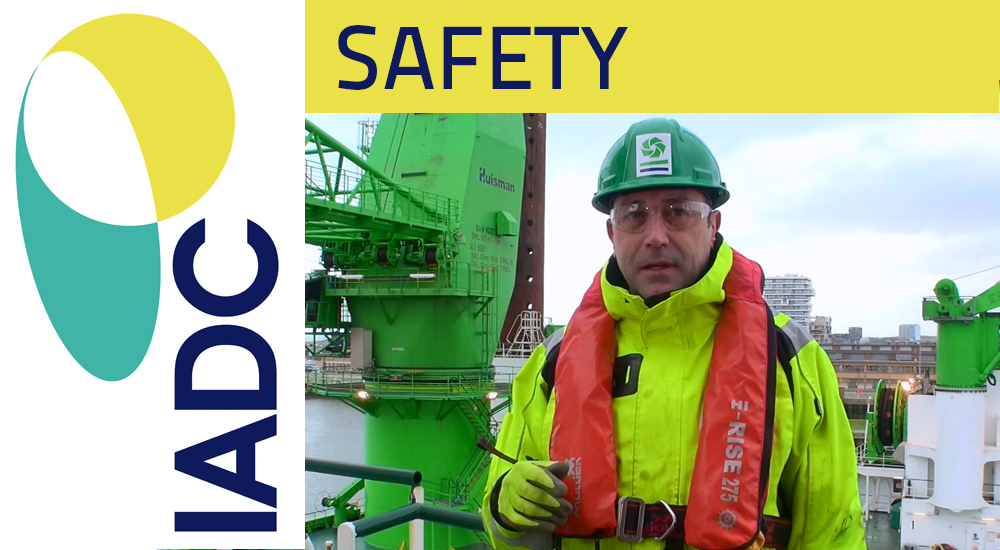
DEME picked up the prestigious IADC Safety Award at IADC’s Annual General Meeting (AGM) at Cascais, Portugal. The award is given to honour companies that have shown outstanding achievement in the area of safety. The award was presented by Peter de Ridder, president of IADC to Lieven Durt, director of QHSE-S DEME and Luc Vandenbulcke, managing director of GeoSea.


